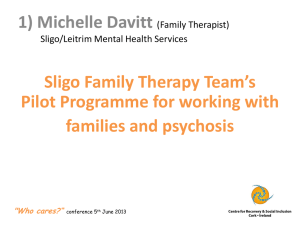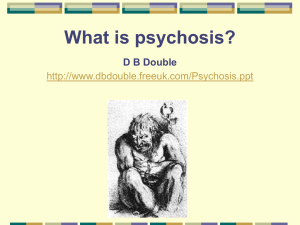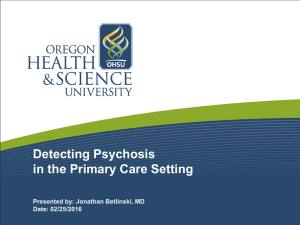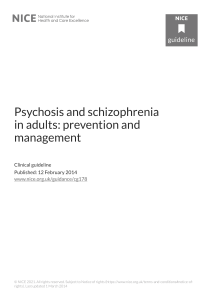Subtle Waves Template
advertisement
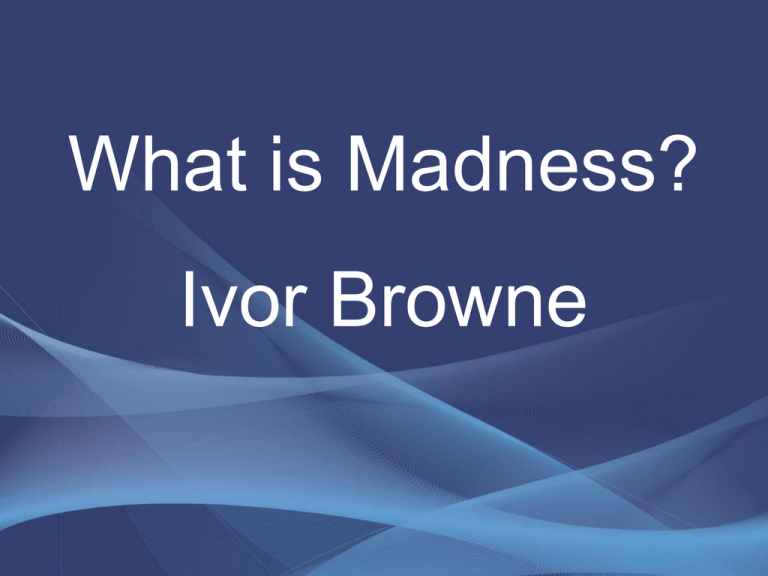
What is Madness? Ivor Browne What is Madness? • Central question to understanding nature of mental health for over 150 years • Critical at present time • Often identified as psychosis/schizophrenia – Continuing confusion Emil Kraepelin (1856-1926) Kraepelin • In 1850’s French psychiatrist Morel (who died in 1873) – catatonia, hebephrenia, dementia paranoides (all same illness) • Kraepelin divided psychiatric disorders into two main categories – Dementia praecox – Manic depressive illness (all mood disorders) ‘Will the Real Concept of Schizophrenia Please Stand Up’? (R.Bentall) • Kraepelin’s views underwent a series of radical transformations throughout 20th century • Four giants of psychiatry Kraepelin 1856 - 1926 Bleuler 1857 - 1939 Jaspers 1883 - 1969 Schneider 1887 - 1967 • Definition remains as confused as ever Two Schools of Thought 1. Bio-Medical Model 2. Psychodynamic Approach Change in Thinking Freud and others who supported psychodynamic viewpoint and/or the bio-medical approach accepted reductionist, scientific determinist view as per orthodox science at the time Psychodynamic Approach – More person centred Adolf Meyer Described reaction types Harry Stack Sullivan Early intervention Gregory Bateson Double Bind Hypothesis Silvano Arieti ‘Interpretation of schizophrenia’ Harry Stack Sullivan As early as 1927 Harry Stack Sullivan spoke of the importance of psychotherapeutic intervention in dealing with psychosis – he stressed relevance of engaging with person as early as possible…. …‘ the psychiatrist sees too many end states and deals professionally with too few of the pre-psychotic.’….’we should lay great stress on the prompt investigation of failing adjustment, rather than, as is so often the case, wait and see what happens’ Living Systems Moving towards new science of ‘living systems’ Psychiatry Today • Humane individuals • Genuine desire to help patients • Psychiatrists retain central position of power, control and legal authority • Only doctors (including psychiatrists) have legal power to medicate or incarcerate Psychiatry Today (Cont’d) • Fear of loss of central role, power and influence • Profound lack of understanding of true nature of emotional disturbance • Recently major developments in psychotherapy and counseling • Solutions now being offered by nonmedical therapists Resistance to Change ‘Ah when people are really sick and unable to manage, or are a threat to themselves or society and need to be contained, they have to come to us to be dealt with’ ‘A Vision for Change’ As is emphasised over and over again in the report of the expert group on Mental Health Policy, which is now official government policy….. ‘This group of service users is perhaps the most vulnerable in the mental health service, and ultimately the quality of the service overall can be measured by the quality of care provided to this group’ Recent Trends • Growing evidence of a revival of interest in psychotherapeutic interventions: – Loren Mosher – Soteria House – R. D. Laing – Kinglsey House Project – Joshua Bierer – Marlborough Day Hospital – Gould Farm Village – Detect programme – Early intervention - Ireland – Western Lapland, Finland – Open Dialogue – Patrick McGorry – Australia UNDERSTANDING PSYCHOSIS Are We Asking the Wrong Question? • We’ve been asking how much is nature and how much is environment • After 150 years of study and research we are no closer to a workable solution • What should we be asking? • Nature and nurture are part of a continuous process of learning Central Dogma • ‘DNA makes RNA, RNA makes protein, and protein makes us’ • ‘Language of life’ • Rosalind Franklin – original research 1953 – structure of DNA molecule Genetic/Environmental Influences • Early studies poorly designed • Looked at frequency occurring in families • Failed to address how far influences were genetic in origin • Later studies – nature vs nurture • Monozygotic and dizygotic twins – Methodological deficiencies in design of all studies Two Key Omissions 1. Epi-genetics 2. Influence of environment on infant in the womb – from conception up to and including birth Epi-Genetics ‘Control above Genetics’ • Profoundly changes our understanding of how life is controlled • Research has established that DNA blueprints passed down through genes are not set in concrete at birth • Genes are not destiny! Epigenic Control • Misunderstanding about the true nature of mental and emotional distress • Genetic influence in the Genesis of Psychosis is likely to be indirect and of limited relevance • Relates to ‘personality’ – not illness Personality vs Pathology • Personality traits are not illness • Jung – Introvert/Extrovert – about preferences not illness • Either dimension can be equally successful Evelyn Fox Keller ‘The secrets of life have proved vastly more complex and more confusing than they seemed in the 1960’s and 70’s’ ‘in the 1990’s we learned that chimps shared 98.5% of human DNA’ Peter Holland ‘the differences between flies and mice, and even between chimps and humans are unmistakeable’ ‘if the genes are ‘essentially the same’, what then is it that makes one organism a fly and another a mouse, a chimp or a human.’ Mae-Wan Ho ‘by this exclusive focus on genes, the living organism tends to be regarded simply as a collection of genes,’ ‘Lamarck's theory – transformation arising from the organism’s own activities and experience of its environment. This requires a conception of the organism as an active, autonomous being, which is open to the environment.’ Lynn Margulis ‘Cell heredity, both nuclear and cytoplasmic, always must be considered for the entire cell, the entire organism’ Infant on High Alert • Mothers under stress, e.g. violence or domestic abuse, can transfer hormonal state to infant in the womb • ‘Fight or flight’ survival stance • Infants anxious and miserable at birth • Maternal depression also associated with newborn anxiety and excessive crying Social Life of Twin Foetuses • ‘Kind’ twins can be seen gently interacting, playing, cheek to cheek • Show interest in each other • Twin boys in the same compartment can be seen ‘boxing’ with each other • Others can be seen kissing or holding hands Psychotic Individuals • Numerous studies have demonstrated that majority are in late teens or early twenties. • Most vulnerable group in health service • Can be very gifted personalities • Can be introverted and sensitive • Have difficulty making social relationships • Behaviour can be bizarre or intolerable Treating Psychosis • Common practice to treat by admission (voluntarily or forcibly) to a secure ward • Administering of powerful medication to control positive symptoms • This method of treatment is central question at the heart of psychiatry Treating Psychosis (Cont’d) • Process of moving repeatedly between hospital and home - behaviour and general condition deteriorates • Become further and further separated from the outside world • They become entrained into a pathway of illness. Treating Psychosis (Cont’d) • It is frightening how quickly this can happen, they lose hold of their social network; they dropout of work, school or college, lose contact with friends, who move on with their own lives, and become increasingly isolated. • Gradually their diagnosis is changed. The psychiatrists looking after them now decide that they are suffering from schizophrenia. Treating Psychosis (Cont’d) • Concept of schizophrenia is created, due to some supposed organic or biochemical cause. • Thus, it can be said that this serious condition is partly ‘iatrogenic’ - that is actually caused by medical treatment. Psychotic Individuals • Not usually possible to manage in office environment once a week • Frequently won’t turn up for appointment • Usually in dependent state in parental home • Take little or no responsibility for themselves Psychotic Individuals (Cont’d) In these circumstances it is simply not possible for a therapist to achieve an effective outcome Trauma & Family Influence • • • • • • • Lack of love – unwanted Cosseting and overprotection Criticism - denigration Scapegoating Bullying in school or by friends Physical or sexual abuse Heavy drinking or drug abuse – a trigger Trauma – Family Influence Independence (Adulthood) Child Family system Trauma S e p a r a t i o n Work Money Relationships Children Trauma Isolation Dependence on family Break with reality Fantasy world Psychosis Treatment -hospitalisation Trauma Dependence Philip Larkin “They fuck you up, your mum and dad. They may not mean to, but they do. They fill you with the faults they had And add some extra, just for you. But they were fucked up in their turn By fools in old-style hats and coats, Who half the time were soppy-stern And half at one another's throats. Alternative Avenue This presentation proposes an alternative avenue of therapy with sustainable recovery for this sensitive group of individuals CREATING A HEALING ENVIRONMENT Healing Environment What is required is a total loving and supportive environment, within which individuals feel safe enough to undertake the necessary therapeutic work. Healing Environment (cont’d) • • • • Supportive setting Close to nature Loving, tolerant and flexible Informed by love and compassion on a deep spiritual basis Therapeutic Relationship • Personal friendship and loving relationship core around which all therapeutic processes rotate • Heart to heart – one human being to another • Objectivity • Clear conditions under which work is done • Individual must do the work – with support Range of Therapies • Broad range of psychotherapeutic interventions • Horticulture and farming (work with animals) • Wholesome Diet & Healthy Living • Body therapy & homeopathy • Arts & crafts • Music • House maintenance Family Work • Several aspects – not about blame – Understanding the family as a separate living system – Open dialogue – Exposing myths & secrets – Crisis intervention • Roles & responsibilities Therapeutic Education (Group Work) • Distinguish that which originates from outside from internal activity • ‘Self’ is what is in question in psychosis • To distinguish ‘self’ from ‘non-self’ • Help individuals to understand psychotic process - hallucinations and delusions Psychiatric Consultation • Anti-psychotic medication – May be necessary to make contact & establish therapeutic relationship – For as short a time as possible & in as low a dosage as possible • Undertake objective unbiased research comparing this pilot project to traditional bio-medical model of treatment Connectedness • Facility must remain connected to community and society in general • Connections to training & rehabilitation must be maintained and strengthened • Not all individuals will be able to integrate into our current society • A growing minority are choosing a more sustainable approach to life, in harmony with nature Krishnamurti ‘It is no measure of health to be well adjusted to a profoundly sick society’ Pilot Projects • Ideally should be pilot group of four or five residential therapeutic centres – on a temporary basis • Spread throughout the country – at least one in each of the four provinces • Must happen in a small country, where it cannot easily be ignored Major Implications • If alternative development could be demonstrated to be more effective – Radical re-organisation of psychiatric practice – Financially much less costly – Fundamental change of direction – Radical re-organisation of psychiatric training, and operation of mental health services generally Thank You Any Questions?




